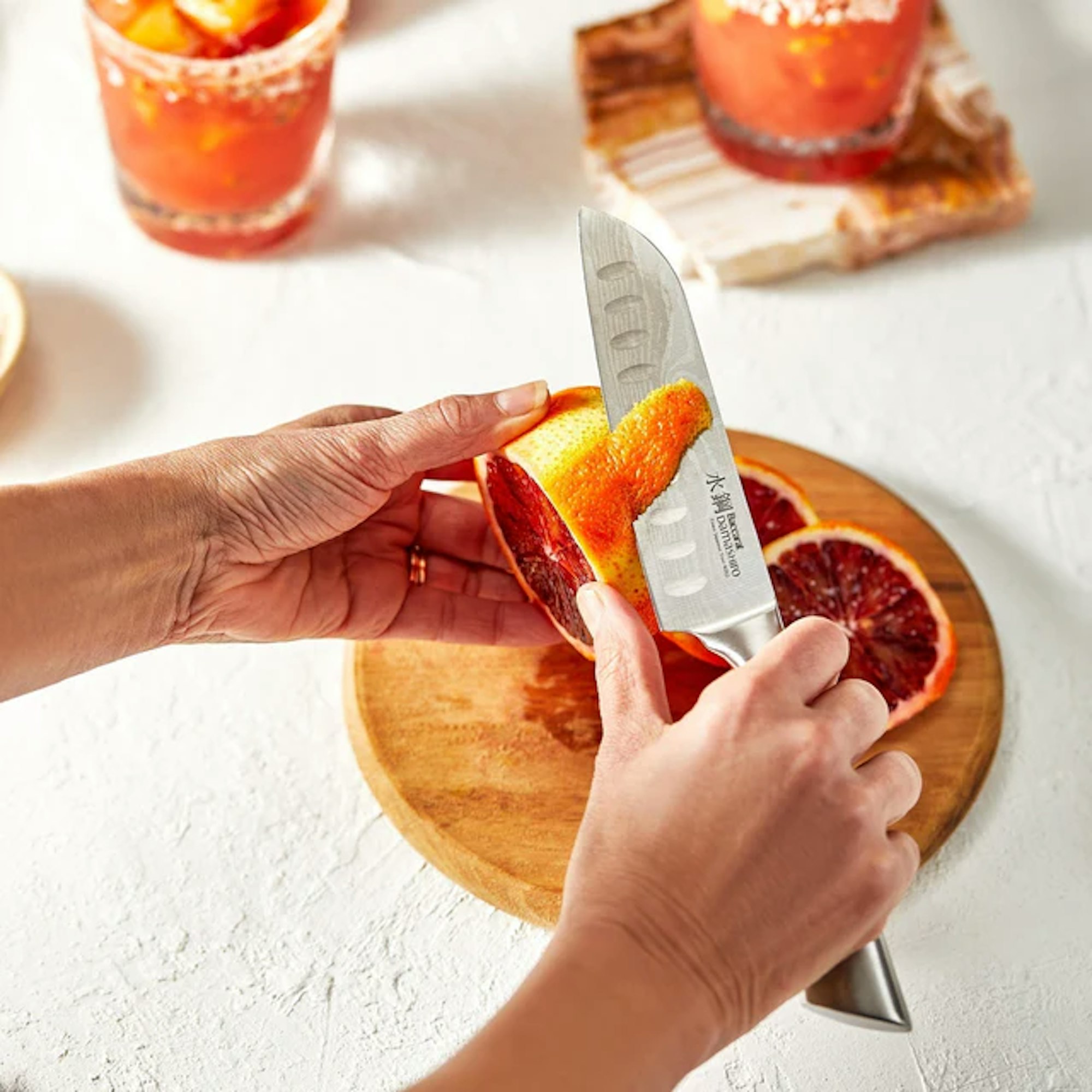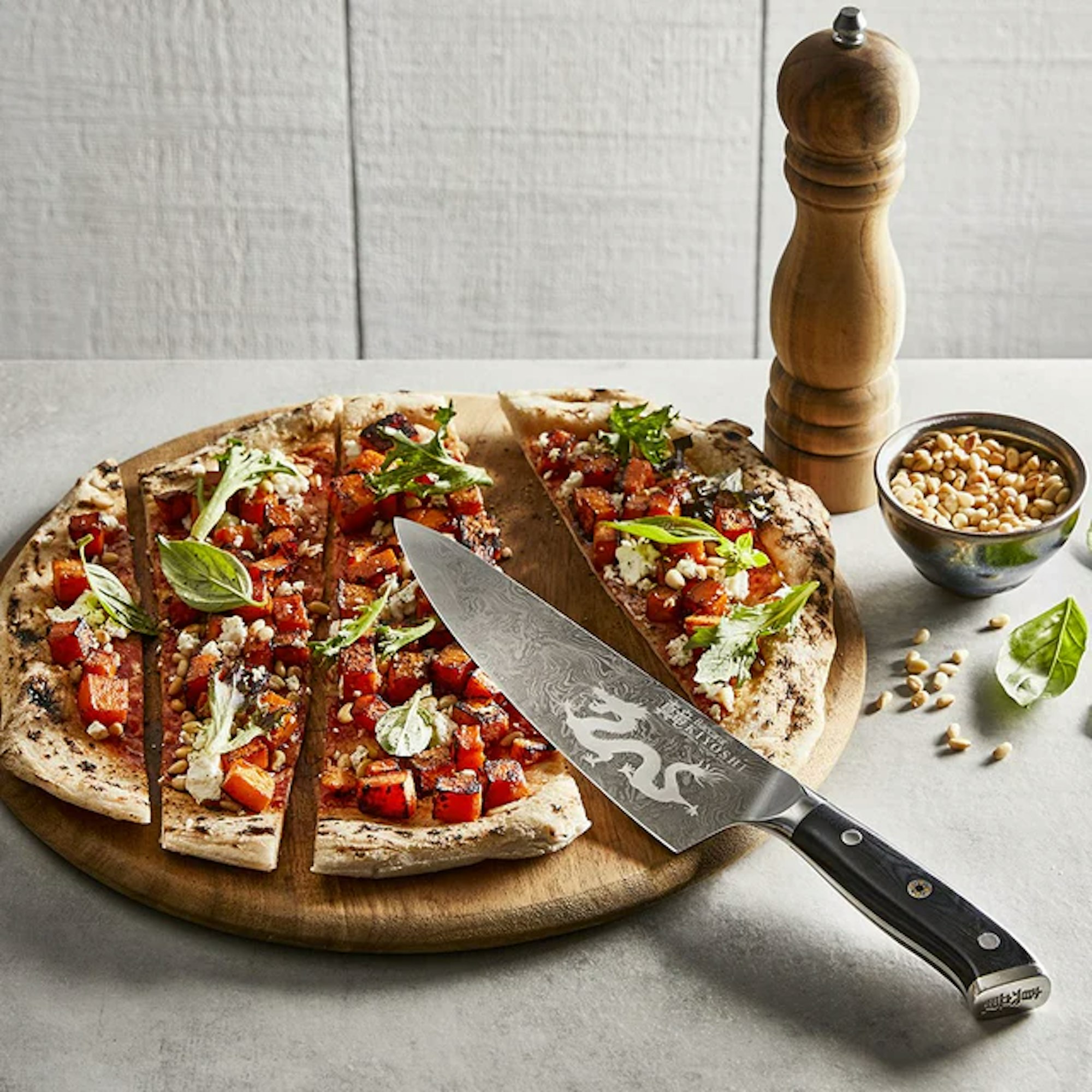Santoku vs Chef Knives: What's the Difference?

When it comes to kitchen knives, there are a plethora of options available. Two popular choices are the santoku knife and the chef's knife. While they may seem similar at first glance, several key differences set them apart. In this blog, we are sharing the difference between Santoku and chef knives so you can know which ones are better suited to different kinds of cooking and prepping tasks.
What Is a Santoku Knife?

A santoku knife is a Japanese knife that translates to "three virtues" or "three uses" in English. It refers to its ability to handle three types of cutting tasks - slicing, dicing, and mincing. It typically has a shorter, wider blade with a flat cutting edge, making it ideal for cutting vegetables, fruits, and boneless meats.
What Is a Chef's Knife?

A chef's knife, also known as a cook's knife, is a versatile knife used for a variety of tasks in the kitchen. It typically has a longer, narrower blade that tapers to a point, allowing for a variety of cutting techniques. The knife is designed to handle various tasks such as slicing, dicing, chopping, and mincing.
What Are the Similarities Between Santoku and Chef Knives?
Despite their differences, both the santoku knife and the chef's knife share some similarities. They are both general-purpose knives that can handle a wide range of cutting tasks. Whether you need to chop vegetables, slice meat, or mince herbs, both knives can get the job done efficiently.
What Are the Differences Between Santoku and Chef Knives?

There are several key differences between santoku and chef's knives.
1. Origin
Santoku knives originate from Japan, while chef's knives have European roots, particularly in Germany and France. This distinction in origin influences various aspects of the knives, including their design and manufacturing techniques.
2. Shape of Blade
Another noticeable difference is the shape of the blade. Santoku knives have a shorter, wider blade with a flat edge, while chef's knives have a longer, narrower blade and a slight curve towards the tip.
The shape of the blade affects the cutting technique and the precision with which you can make thin slices. The flat edge of a Santoku knife allows for more precise cuts, making it ideal for delicate tasks like slicing sushi or sashimi.
3. Blade Thickness
Blade thickness is another distinguishing factor. Santoku knives tend to have thinner blades compared to chef's knives. This thinner blade allows for more precise, controlled cutting, making it easier to create thin slices of vegetables or meat. A chef's knife is typically thicker to provide more stability and durability during heavy-duty tasks.
4. Bevel Sides
The bevel sides of the blades differ between the two knives. Santoku knives have a flat bevel on both sides, while chef's knives typically have a bevel on one side and a flat edge on the other. This bevel difference affects the cutting technique and the ease of sharpening the knife.
5. Weight Balance
Weight balance is an important aspect to consider, as it can directly impact how you use the knife and your comfort. Santoku knives are generally more evenly balanced, with the weight evenly distributed along the blade and handle. In contrast, chef's knives tend to have more weight towards the blade, providing more power for chopping and slicing tasks.
6. Size
Santoku knives are typically shorter, ranging from 5 to 7 inches, while chef's knives are longer, ranging from 8 to 10 inches. The size difference affects the maneuverability and the amount of control you have over the knife.
7. Sharpening Method
When it comes to sharpening, the two knives also have different methods. Santoku knives are usually sharpened at a 15-degree angle on each side, while chef's knives are sharpened at a 20-degree angle on one side.
8. Handle
Santoku knives typically have a traditional Japanese handle, which is lighter and more rounded. In contrast, chef's knives often have a heavier, ergonomic handle designed for a comfortable grip during prolonged use.
Why Does the Blade Shape Matter?
The shape of the blade plays a crucial role in the precision and control you have over your cuts. The flat edge of a Santoku knife allows for thinner slices, making it ideal for tasks that require delicate precision. On the other hand, the curved blade of a chef's knife enables a rocking motion, which is useful for tasks like mincing garlic or chopping herbs.
When Should You Use Each Type of Knife?
A Santoku knife is perfect for tasks that require precision and delicate slicing, such as preparing sushi, sashimi, or vegetables for stir-frying. On the other hand, a chef's knife is more versatile and suitable for a wide range of tasks, including chopping, slicing, and dicing.
While Santoku and chef's knives are both general-purpose knives, they have distinct differences from their origin to blade shape, thickness and much more. Understanding these differences will help you choose the right knife for your specific cooking needs. Whether you prefer the precision of a Santoku knife or the versatility of a chef's knife, both options will elevate your culinary skills.
Discover our wide range of Santoku and chef’s knives from House and find what suits your kitchen needs.
Back to blog



